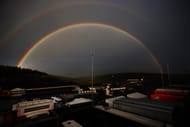
Rainbows form over the track following qualifying for the Belgian Formula One Grand Prix at the Circuit of Spa Francorchamps on August 27, 2011 . (Getty Images)
1982 Belgian GP: Adieu Gilles
Formula 1 didn’t become a relatively safe sport until after Ayrton Senna‘s accident. Even after shifting the race from the dangerous Spa-Francorchamps to a low risk track like Zolder, accidents didn’t stop and in 1982 claimed the life of one of the best drivers ever – Gilles Villeneuve – during qualifying.
Legend has it that Gilles was hell-bent on beating the lap time of teammate Didier Pironi after the unfair treatment he received at San Marino earlier that year. Whatever the case, we lost a fascinating prospect just due to poor safety standards.
1966 Belgian GP: Jackie Stewart’s crusade for safety
Jackie Stewart suffered the worst accident of his career at Spa in 1966. As his car overturned, he was unable to pull himself out from under the burning car. Had it not been for teammate Graham Hill and Bob Bondurant, Stewart would have surely lost his life.
From there on, Stewart turned his attention towards improving safety in the sport and led the contingent of drivers against the organising authorities. On many occasions, he and his team had threatened to boycott a race but somehow the situation was brought under control until the 1969 Belgian Grand Prix where Stewart finally had his way.
Things didn’t improve dramatically very soon but Stewart’s determination combined with the governing body learning lessons from further fatal accidents of Jochen Rindt, Piers Courage, Francois Cevert, Ronnie Peterson, Tom Pryce and many others gave rise to a series of reforms, which has made what F1 is today in terms of safety.
1960 Belgian GP: Darkest weekend in the history of F1
Many would consider the 1994 San Marino weekend to be the worst but there was one at Spa, which beats that. During the 1960 Belgian Grand Prix weekend, two drivers – Chris Bristow and Alan Stacey – were killed during the race.
One can only imagine Jim Clark’s state of mind when he had to swerve more than once to avoid Bristow’s headless body lying in the middle of the track. Not only that, Stirling Moss and Mike Taylor crashed heavily during the weekend and suffered serious injuries.
Masta Kink
No discussion about the history of Spa-Francorchamps is ever complete without the mention of Masta Kink. Now, Eau Rouge is considered to be one of the most challenging corners but it pales out when compared to the Masta Kink on the old Spa circuit.
It was basically a quick left right with farmhouses either side of the track and very close to it. One mistake, and bam, one crashes into one of the houses.
In those days, the drivers used to take the corner at over 150 mph; nowadays Eau Rouge is taken at that speed but with four layers of fireproof clothing and a full-faced helmet made out of bulletproof material in a car with so much downforce that it is capable of running upside down inside the Monaco tunnel.
Compare that to the 50′s when the drivers basically sat inside a ‘tub’ with just a t-shirt, goggles and a basic helmet to protect them and preferred to jump out of their cars rather than being strapped inside when an accident seemed inevitable.
Think that’s enough daredevilism? Famous F1 journalist Denis Jenkinson used to be seated inside one of those farmhouses near the Masta Kink because he thought it would be the best position to analyse the driving styles of various drivers.
The Belgian Grand Prix is one of the oldest and revered on the calendar along with the British and Italian Grand Prix’s and we hope that Bernie Ecclestone – or his successor – would be sensible enough to keep the race on the calendar.
Everybody would agree that most of the new races outside Europe don’t have the required atmosphere and therefore it would be good for the sport to return to its homeland.
